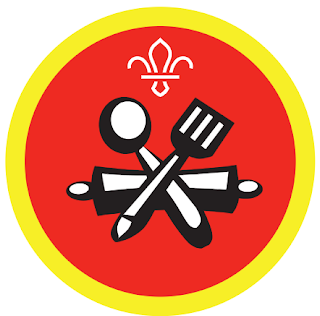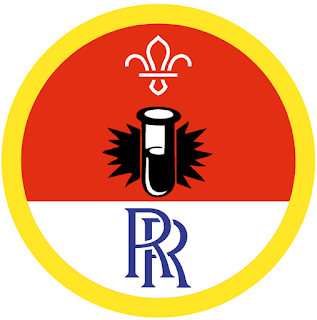Cubs: Chef Activity Badge
How to earn your badge:
Learn the basic rules of safety and hygiene in the kitchen.
Explain why they’re important.Think of things in the kitchen which may be dangerous or hazards. For example, you might think about electricity, bacteria, sharp objects, or hot things. Think about things we do to stay safe in the kitchen. You might come up with ideas like wearing oven gloves, washing hands, and wiping surfaces, for example.Print out the rospa worksheet can you spot all the hazards? There are lots of dangers in the kitchen. Here are some to talk about with your parent/carer: Kettle with hanging cord – scald, Oven – burn, Pot on stove with handle sticking out – burn, Sharp knives – cut, Water spill on floor – slip, Open lower drawers – trip, Bottle of bleach – poisoning, Drawers – trapped finger, Skateboard – trip, Washing machine – injury risk from machine itself, and liquid laundry capsules, Hot drink – scaldPrint enough bingo cards for every person in your family to have one each. Print a copy of all of the possible tiles, and cut it up. Fold each of the images, and put them in a bowl, ready to choose from later. Give everyone a bingo card and a pen. The person leading the game should take a folded tile out of the bowl, unfold it, and call out what’s on it. Everyone who has that hazard and safety tip on their card should cross it out. The person leading the game should keep choosing tiles from the bowl, calling each one out. The players should listen carefully, and cross out the images on their sheet as they’re called. When a player has marked a line in any direction (from side to side or top to bottom) they call ‘line!’. When a player has marked off all of the tiles on their card, they call ‘bingo!’. The first player to call ‘bingo!’ is the winner. Everyone should talk about the different things on their card. What are the hazards? How do the tips help keep everyone safe?This activity helped you to develop skills. Is being safe in the kitchen a skill? Are you already skilled in the kitchen, or are there more skills you’d like to develop? Which kitchen skills would you like to practice? Do you know how to be clean and safe in the kitchen now? What did you learn during this activity? This activity also reminded you why it’s important to live healthily. How does following the safety tips keep you healthy? Why is it important to make sure you’re clean and sensible in the kitchen? How else does cooking your own food help you to live healthily?Talk to your leader about the different ways of preparing and cooking food.
Think of as many different ways of cooking somethings you can then print out this information sheet. Did you think of them all?What cooked meals have you eaten this week, how they were cooked? Think of your favourite food, how is this cooked?Looking at the different ways of cooking. Which methods do you like? Why might we choose each method? What kinds of things do we think about when we choose a method (for example, taste, texture, health). Can you think of a food for each different cooking method? Ask your parents/carer to think of different meals and you can work out how they were cooked.This game helped you to think about skills. Is it a skill to know how you might cook different foods? Do different methods of cooking use different skills? Which methods have you tried before? Which methods would you like to try? Which methods do you think would be easiest or trickiest to use?This game also helped you to be able to live healthily. Why is it important to eat a variety of foods? Do you think a balanced diet includes lots of different ways of cooking? What sorts of things do you need to think about to choose a healthy way of cooking (for example, making sure food is cooked thoroughly, keeping nutrients in food where you can, making sure the food still tastes good so you enjoy eating it)?Learn what the major food groups are.
How do they fit into a healthy diet?Print out this work sheet and cut out them up along the dotted lines.Talk about what you think the main food groups are, what a healthy diet looks like, and whether it’s important to have a healthy diet.Ask your parent/carer to call out a food group. You need to pick up an item from that food group that you think would be a tasty addition to lunch. Put it into your lunch box. Your parent/carer should call out all of the food groups once. They should then call them all out again, in a different order this time, until you have plenty of items in your lunchbox. Look at the items you have chosen in your lunchbox, and think about the foods inside. How could you use the foods in your lunchbox to make a tasty meal?This activity helped you to develop skills. Why is it important to be able to plan a healthy meal? Do you usually help to choose the food you eat? When you looked at your lunchbox, could you find a way to combine the foods to make a meal? Were some foods trickier to put together in the same meal?This activity also helped you think about living healthily. Can you remember the different food groups that make up a balanced diet? Did you learn anything new about balanced diets? Why is it important to try and eat some food from each group? Did you see any foods you haven’t tried before?Plan, cook, serve and clear away a two-course meal for at least two people.
You should prepare and cook vegetables as part of the menu. Remember, an adult must supervise you for this step. Talk to the people you’re cooking for about the menu.Ask your parent or carer to help you plan a two course meal for at least two people to cook with their help. Ask your parent or carer to find or shop for the ingredients you need.Once your parent or carer has had time to shop for the ingredients needed, get ready to cook by tying up your hair, putting on an apron, and washing your hands.Now may be a good time to check you remember about being clean and safe in the kitchen Make sure to wipe down the surface with disinfectant spray before you start cooking.Everyone should follow their 2 recipes to create a delicious meal. Make sure you help with washing up, tidying, and wiping down surfaces. An adult should remove the finished dish from the oven. Remember that ovens take time to cool, so they can still be dangerous even if they’re switched off.This activity was a chance for you to practice the skills and knowledge you have while learning new ones and making a tasty feast. As everyone enjoys their food, you can talk about the skills you used when cooking. Did anyone try something new? Some Cubs may not have opened tins, grated, or mashed things before. Did anyone taste a new food? It was important to use the skills you already had, including being safe and clean in the kitchen, while learning new ones. Can anyone name some things that adults should still help with? You may think about hot things or sharp things.This activity was also a chance to be independent. You had to make your own decisions, for example, adjusting the taste when you made a dressing, or deciding what vegetables to add to their dish. Did anyone have a chance to try something other people normally do for them? You may think about chopping vegetables or using a grater. It’s great to achieve things for yourself – well done!Safety
- Food
- Check for allergies before you begin. Make sure you have suitable areas for storing and preparing food and avoid cross contamination of different foods.
- Cooking
- Teach young people how to use cooking equipment safely. Supervise them appropriately throughout. Make sure it’s safe to use and follow manufacturers’ guidelines for use.
- Sharp objects
- Teach young people how to use sharp objects safely. Supervise them appropriately throughout. Store all sharp objects securely, out of the reach of young people.
All activities must be safely managed.Next Cub Badge: 01/04/2020






